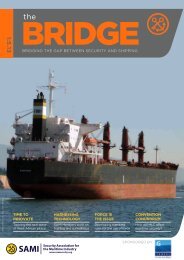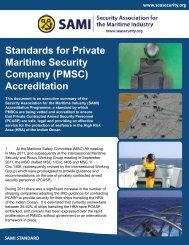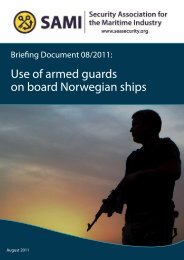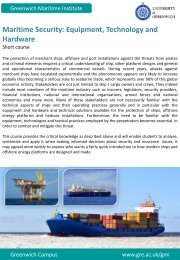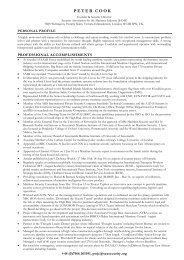SAMI Briefing Maritime Labour Convention FAQs and Text March 2013
SAMI Briefing Maritime Labour Convention FAQs and Text March 2013
SAMI Briefing Maritime Labour Convention FAQs and Text March 2013
You also want an ePaper? Increase the reach of your titles
YUMPU automatically turns print PDFs into web optimized ePapers that Google loves.
obligations <strong>and</strong> rights with the specific details set out in the Regulations <strong>and</strong> the Code. TheArticles also contain provisions relating to the legal aspects of the operation <strong>and</strong>application of the <strong>Convention</strong> such as definitions, amendments <strong>and</strong> entry into force <strong>and</strong> theestablishment of the Special Tripartite Committee under Article XIII. The differencebetween the Regulations <strong>and</strong> the St<strong>and</strong>ards <strong>and</strong> Guidelines is that the Regulations arenormally worded in very general terms, with the details of implementation being set out inthe Code (i.e., the St<strong>and</strong>ards <strong>and</strong> the Guidelines).A11. What is a “substantially equivalent” provision?The MLC, 2006 provides in Article VI, paragraphs 3 <strong>and</strong> 4, that in somecircumstances a national provision implementing the rights <strong>and</strong> principles of the<strong>Convention</strong> in a manner different from that set out in Part A of the Code will be consideredas “substantially equivalent” if the Member concerned “satisfies itself” that the relevantlegislation or other implementing measure “is conducive to the full achievement of thegeneral object <strong>and</strong> purpose of the provision or provisions of Part A of the Code concerned”<strong>and</strong> “gives effect to the provision or provisions of Part A of the Code concerned”. TheMember's obligation is principally to “satisfy itself”, which nevertheless does not implytotal autonomy, since it is incumbent on the authorities responsible for monitoringimplementation at the national <strong>and</strong> international levels to determine not only whether thenecessary procedure of “satisfying themselves” has been carried out, but also whether ithas been carried out in good faith in such a way as to ensure that the objective ofimplementing the principles <strong>and</strong> rights set out in the Regulations is adequately achieved insome way other than that indicated in Part A of the Code. It is in this context that ratifyingmembers should assess their national provisions from the point of view of substantialequivalence, identifying the general object <strong>and</strong> purpose of the MLC, 2006 Code, Part Aprovision concerned (in accordance with paragraph 4(a)) <strong>and</strong> determining whether or notthe proposed national provision could, in good faith, be considered as giving effect to thePart A provision (as required by paragraph 4(b)). Any substantial equivalents that havebeen adopted must be stated in Part I of the declaration of maritime labour compliance thatis carried on board ships that have been certified [see C5.1.k. How detailed should Part I ofthe declaration of maritime labour compliance (DMLC) be?].A12. What is the status of the Guidelines in Part B of the Code?Countries that ratify the MLC, 2006 must adopt national laws or take other measuresto ensure that the principles <strong>and</strong> rights set out in the Regulations are implemented in themanner set out by the St<strong>and</strong>ards set out in Part A of the Code (or in a substantiallyequivalent manner [see A11. What is a “substantially equivalent” provision?] Whendeciding on the details of their laws or other implementing measures [see A.8 Whatmeasures must a country take to ensure that the MLC, 2006 is properly applied?], theratifying countries must give due consideration to following the Guidelines set out inPart B of the Code. Provided that they have given this due consideration, ratifyingcountries may implement the m<strong>and</strong>atory provisions in a different way, more suited to theirnational circumstances. In this case, the government concerned may be asked to explain tothe ILO supervisory bodies why it has decided not to follow the guidance in Part B of theCode (see Report Form). 10 A country’s implementation of Part B will not be verified byport State inspectors.10 See footnote 8.FAQ 7





